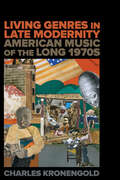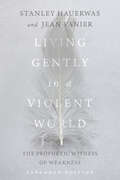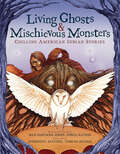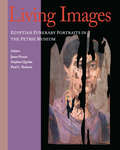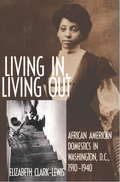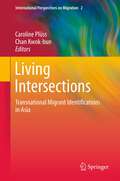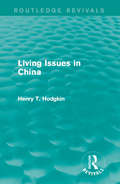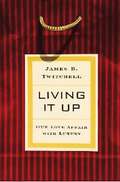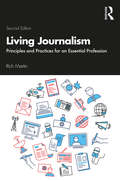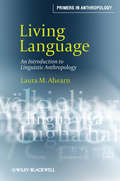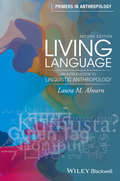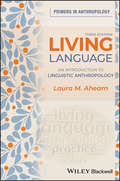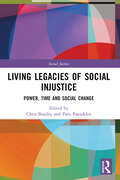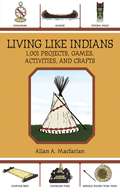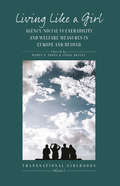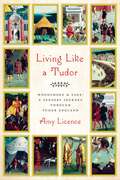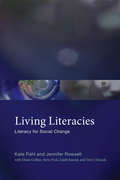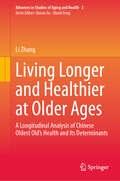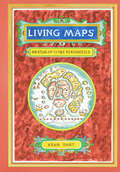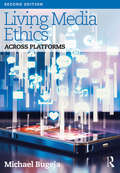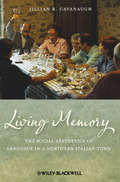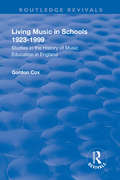- Table View
- List View
Living Genres in Late Modernity: American Music of the Long 1970s
by Charles KronengoldLiving Genres in Late Modernity rehears the American 1970s through the workings of its musical genres. Exploring stylistic developments from the late 1960s through the early 1980s, including soul, funk, disco, pop, the nocturne, and the concerto, Charles Kronengold treats genres as unstable constellations of works, people, practices, institutions, technologies, money, conventions, forms, ideas, and multisensory experiences. What these genres share is a significant cultural moment: they arrive just after "the sixties" and are haunted by a sense of belatedness, loss, or doubt, even as they embrace narratives of progress or abundance. These genres give us reasons—and means—to examine our culture’s self-understandings. Through close readings and large-scale mappings of cultural and stylistic patterns, the book’s five linked studies reveal how genres help construct personal and cultural identities that are both partial and overlapping, that exist in tension with one another, and that we experience in ebbs and flows.
Living Gently in a Violent World: The Prophetic Witness of Weakness (Resources For Reconciliation)
by Stanley Hauerwas Jean VanierHow are Christians to live in a violent and wounded world? Rather than contending for privilege by wielding power and authority, we can witness prophetically from a position of weakness. The church has much to learn from an often-overlooked community—those with disabilities. <p><p> In this fascinating book, theologian Stanley Hauerwas collaborates with Jean Vanier, founder of the worldwide L'Arche communities. For many years, Hauerwas has reflected on the lives of people with disability, the political significance of community, and how the experience of disability addresses the weaknesses and failures of liberal society. And L'Arche provides a unique model of inclusive community that is underpinned by a deep spirituality and theology. Together, Vanier and Hauerwas carefully explore the contours of a countercultural community that embodies a different way of being and witnesses to a new order—one marked by radical forms of gentleness, peacemaking, and faithfulness. <p> The authors' explorations shed light on what it means to be human and how we are to live. The robust voice of Hauerwas and the gentle words of Vanier offer a synergy of ideas that, if listened to carefully, will lead the church to a fresh practicing of peace, love and friendship. This invigorating conversation is for everyday Christians who desire to live faithfully in a world that is violent and broken. <p> This expanded edition now includes a study guide for individual reflection or group discussion.
Living Ghosts and Mischievous Monsters: Chilling American Indian Stories
by Dan SaSuWeh JonesPerfect for fans of Scary Stories to Tell in the Dark! A shiver-inducing collection of short stories to read under the covers, from a breadth of American Indian nations.Dark figures in the night. An owl's cry on the wind. Monsters watching from the edge of the wood.Some of the creatures in these pages might only have a message for you, but some are the stuff of nightmares. These thirty-two short stories -- from tales passed down for generations to accounts that could have happened yesterday -- are collected from the thriving tradition of ghost stories in American Indian cultures across North America. Prepare for stories of witches and walking dolls, hungry skeletons, La Llorona and Deer Woman, and other supernatural beings ready to chill you to the bone.Dan SaSuWeh Jones (Ponca Nation) tells of his own encounters and selects his favorite spooky, eerie, surprising, and spine-tingling stories, all paired with haunting art by Weshoyot Alvitre (Tongva).So dim the lights (or maybe turn them all on) and pick up a story...if you dare.
Living History
by Hillary Rodham ClintonHillary Rodham Clinton is known to hundreds of millions of people around the world. Yet few beyond her close friends and family have ever heard her account of her extraordinary journey. She writes with candor, humor and passion about her upbringing in suburban, middle-class America in the 1950s and her transformation from Goldwater Girl to student activist to controversial First Lady. Living History is her revealing memoir of life through the White House years. It is also her chronicle of living history with Bill Clinton, a thirty-year adventure in love and politics that survives personal betrayal, relentless partisan investigations and constant public scrutiny. Hillary Rodham Clinton came of age during a time of tumultuous social and political change in America. Like many women of her generation, she grew up with choices and opportunities unknown to her mother or grandmother. She charted her own course through unexplored terrain -- responding to the changing times and her own internal compass -- and became an emblem for some and a lightning rod for others. Wife, mother, lawyer, advocate and international icon, she has lived through America's great political wars, from Watergate to Whitewater. The only First Lady to play a major role in shaping domestic legislation, Hillary Rodham Clinton traveled tirelessly around the country to champion health care, expand economic and educational opportunity and promote the needs of children and families, and she crisscrossed the globe on behalf of women's rights, human rights and democracy. She redefined the position of First Lady and helped save the presidency from an unconstitutional, politically motivated impeachment. Intimate, powerful and inspiring, Living History captures the essence of one of the most remarkable women of our time and the challenging process by which she came to define herself and find her own voice -- as a woman and as a formidable figure in American politics.
Living History
by Hillary Rodham ClintonHillary Rodham Clinton is known to hundreds of millions of people around the world. Yet few beyond her close friends and family have ever heard her account of her extraordinary journey. She writes with candor, humor and passion about her upbringing in suburban, middle-class America in the 1950s and her transformation from Goldwater Girl to student activist to controversial First Lady. Living History is her revealing memoir of life through the White House years. It is also her chronicle of living history with Bill Clinton, a thirty-year adventure in love and politics that survives personal betrayal, relentless partisan investigations and constant public scrutiny. Hillary Rodham Clinton came of age during a time of tumultuous social and political change in America. Like many women of her generation, she grew up with choices and opportunities unknown to her mother or grandmother. She charted her own course through unexplored terrain -- responding to the changing times and her own internal compass -- and became an emblem for some and a lightning rod for others. Wife, mother, lawyer, advocate and international icon, she has lived through America's great political wars, from Watergate to Whitewater. The only First Lady to play a major role in shaping domestic legislation, Hillary Rodham Clinton traveled tirelessly around the country to champion health care, expand economic and educational opportunity and promote the needs of children and families, and she crisscrossed the globe on behalf of women's rights, human rights and democracy. She redefined the position of First Lady and helped save the presidency from an unconstitutional, politically motivated impeachment. Intimate, powerful and inspiring, Living History captures the essence of one of the most remarkable women of our time and the challenging process by which she came to define herself and find her own voice -- as a woman and as a formidable figure in American politics.
Living Hungry In America
by J. A. C. Brown H. F. PizerWritten toward the layperson, this is a recounting of a 2 year national study of hunger in America. The authors, plus multiple field teams, traveled America looking at the growing number of hungry people, their changing demographics and the causes of that hunger. The book includes an extensive index, useful for research purposes.
Living Images: Egyptian Funerary Portraits in the Petrie Museum (UCL Institute of Archaeology Publications)
by Stephen Quirke Janet Picton Paul C RobertsThe haunting funerary paintings on wood coffins found in Roman Egypt still represent some of the most vivid images that come to us from the ancient world. These paintings were first discovered by Flinders Petrie, father of modern archaeology, in his excavations in the Egyptian Fayum during the 1880s and have rested at University College London for over 100 years. Now, the Petrie Museum is bringing this corpus of paintings to the public in a stunning catalog. Living Images is a beautiful and authoritative presentation of the restored collection that will be an essential reference for scholars and a fascinating read for general audiences. Central to the volume is a complete catalog of the mummy portraits uncovered by Petrie, including full color illustrations and descriptions of technical and stylistic features and iconographic characteristics. To add to the value of the volume, articles describe the process of finding the mummies, explain the place of funerary assemblages in the history of Egyptian burial customs, offer an introduction to Egyptian portrait painting, and explain the conservation issues presented by the coffins. Petrie’s own reflections on his finds are also included. The volume is dedicated to the memory of Egyptologist Barbara Adams and co-sponsored by the Petrie Museum.
Living In, Living Out
by Elizabeth Clark-LewisThis oral history portrays the lives of African American women who migrated from the rural South to work as domestic servants in Washington, DC in the early decades of the twentieth century. In Living In, Living Out Elizabeth Clark-Lewis narrates the personal experiences of eighty-one women who worked for wealthy white families. These women describe how they encountered--but never accepted--the master-servant relationship, and recount their struggles to change their status from "live in" servants to daily paid workers who "lived out."With candor and passion, the women interviewed tell of leaving their families and adjusting to city life "up North," of being placed as live-in servants, and of the frustrations and indignities they endured as domestics. By networking on the job, at churches, and at penny savers clubs, they found ways to transform their unending servitude into an employer-employee relationship--gaining a new independence that could only be experienced by living outside of their employers' homes. Clark-Lewis points out that their perseverance and courage not only improved their own lot but also transformed work life for succeeding generations of African American women. A series of in-depth vignettes about the later years of these women bears poignant witness to their efforts to carve out lives of fulfillment and dignity.
Living Intersections: Transnational Migrant Identifications in Asia
by Chan Kwok-Bun Caroline PlüssThis book presents ground-breaking theoretical, and empirical knowledge to produce a fine-grained and encompassing understanding of the costs and benefits that different groups of Asian migrants, moving between different countries in Asia and in the West, experience. The contributors--all specialist scholars in anthropology, geography, history, political science, social psychology, and sociology--present new approaches to intersectionality analysis, focusing on the migrants' performance of their identities as the core indicator to unravel the mutual constituitivity of cultural, social, political, and economic characteristics rooted in different places, which characterizes transnational lifestyles. The book answers one key question: What happens to people, communities, and societies under globalization, which is, among others, characterized by increasing cultural disidentification?
Living Issues in China (Routledge Revivals)
by Henry T. HodgkinThis book, first published in 1932, explores several different aspects of life in China at the beginning of the twentieth century including education, family life, economics and religion. This book will be of interest to students of Asian Studies.
Living It Up: Our Love Affair with Luxury
by James B. TwitchellEconomic downturns and terrorist attacks notwithstanding, America's love affair with luxury continues unabated. Over the last several years, luxury spending in the United States has been growing four times faster than overall spending. It has been characterized by political leaders as vital to the health of the American economy as a whole, even as an act of patriotism. Accordingly, indices of consumer confidence and purchasing seem unaffected by recession. This necessary consumption of unnecessary items and services is going on at all but the lowest layers of society: J.C. Penney now offers day spa treatments; Kmart sells cashmere bedspreads. So many products are claiming luxury status today that the credibility of the category itself is strained: for example, the name "pashmina" had to be invented to top mere cashmere.We see luxury everywhere: in storefronts, advertisements, even in the workings of our imaginations. But what is it? How is it manufactured on the factory floor and in the minds of consumers? Who cares about it and who buys it? And how concerned should we be that luxuries are commanding a larger and larger percentage of both our disposable income and our aspirations?Trolling the upscale malls of America, making his way toward the Mecca of Las Vegas, James B. Twitchell comes to some remarkable conclusions. The democratization of luxury, he contends, has been the single most important marketing phenomenon of our times. In the pages of Living It Up, Twitchell commits the academic heresy of paying respect to popular luxury consumption as a force that has united the country and the globe in a way that no war, movement, or ideology ever has. What's more, he claims, the shopping experience for Americans today has its roots in the spiritual, the religious, and the transcendent.Deft and subtle writing, audacious ideas, and a fine sense of humor inform this entertaining and insightful book.
Living Journalism: Principles and Practices for an Essential Profession
by Rich MartinIn this readable, practical textbook Rich Martin explores the core principles and practices that beginning journalists need to produce work that informs and enlightens citizens hungry for accurate and trustworthy news. The textbook’s 16 concise chapters impart real-world examples demonstrating how the best journalists exemplify the key principles, as well as cautionary stories illustrating journalistic mistakes and missteps. It also contains exercises, checklists, tips and additional resources that students can use in class and independent study, making the book an ideal newsroom and classroom resource that can be returned to again and again for new insights. For journalism to survive and flourish in the 21st century, it needs young practitioners who understand its importance to society, believe in and are committed to its core values, and can put those values into action. This new edition of Living Journalism is an excellent updated introduction to journalism for students, teachers and young professionals.
Living Language
by Laura M. AhearnAccessible and clearly written, Living Language: An Introduction to Linguistic Anthropology introduces readers to the study of language in real-life social contexts around the world through the contemporary theory and practice of linguistic anthropology.A highly accessible introduction to the study of language in real-life social contexts around the worldCombines classic studies on language and cutting-edge contemporary scholarship and assumes no prior knowledge in linguistics or anthropologyProvides a unifying synthesis of current research and considers future directions for the fieldCovers key topics such as: language and gender, race, and ethnicity; language acquisition and socialization in children and adults; language death and revitalization; performance; language and thought; literacy practices; and multilingualism and globalization
Living Language: An Introduction to Linguistic Anthropology (Primers in Anthropology #4)
by Laura M. AhearnRevised and updated, the 2nd Edition of Living Language: An Introduction to Linguistic Anthropology presents an accessible introduction to the study of language in real-life social contexts around the world through the contemporary theory and practice of linguistic anthropology. Presents a highly accessible introduction to the study of language in real-life social contexts around the world Combines classic studies on language and cutting-edge contemporary scholarship and assumes no prior knowledge in linguistics or anthropology Features a series of updates and revisions for this new edition, including an all-new chapter on forms of nonverbal language Provides a unifying synthesis of current research and considers future directions for the field
Living Language: An Introduction to Linguistic Anthropology (Primers in Anthropology #4)
by Laura M. AhearnA new, fully revised edition of this bestselling textbook in linguistic anthropology, updated to address the impacts of globalization, pandemics, and other contemporary socio-economic issues in the study of language Living Language: An Introduction to Linguistic Anthropology has introduced thousands of students to the engaging and compelling field of linguistic anthropology. Now in a new, fully updated and revised third edition, this bestselling textbook provides a student-friendly exploration of language as a social and cultural practice. Covering both theory and real-world practice, this clear and highly accessible textbook examines the relationship between language and social context while highlighting the advantages of an ethnographic approach to the study of language. The third edition includes a timely new chapter that investigates how technologies such as social media and online meetings have changed language. The new edition also considers the impact of the COVID-19 pandemic on linguistic practices, ensuring that this text will be a valuable resource for students for years to come. This insightful text: Offers an engaging introduction to the field of linguistic anthropology Features all-new material covering contemporary technologies and global developments Explains how language use is studied as a form of social action Covers nonverbal and multimodal communication, language acquisition and socialization, the relationship between language and thought, and language endangerment and revitalization Explores various forms of linguistic and social communities, and discusses social and linguistic differentiation and inequality along racial, ethnic, and gender dimensions Requiring no prior knowledge in linguistics or anthropology, Living Language: An Introduction to Linguistic Anthropology, Third Edition, is the perfect textbook for undergraduate and graduate courses in introductory linguistic anthropology as well as related courses in sociolinguistics, sociology, and communication.
Living Legacies of Social Injustice: Power, Time and Social Change (Social Justice)
by Chris Beasley Pam PapadelosThrough a wide range of international and interdisciplinary case studies, this book develops the notion of legacy, and in particular, ‘living legacy’– that is, it explores power relations in the context of time as a means to considering and challenging social injustice. Legacies of social injustice are very frequently erased, denied or declared redundant. Framed by the concept of ‘legacy’, this book does not conceive legacy as simply referring to relics of the past, or to cultural heritage practices and artifacts. Instead, the book focuses upon ‘living legacies’, understood as ongoing, actively engaged in the re-constitution of power relations, and influential in the development of alternative political imaginaries. Through a variety of studies from many different contexts—including Indigenous trauma in Australia, displacement in Beirut, women travellers in Scotland, and heteronormativity in Hollywood—the book draws not only upon historiographic, sociological, legal, political, cultural and other disciplinary approaches, but also specifically makes use of feminist and postcolonial perspectives. Foregrounding the legacies of inequality and marginalisation, it contributes to a re-thinking of power and social change in ways that together suggest potential means for unsettling and reimagining such legacies. This book will appeal to an interdisciplinary range of readers with interests and concerns in the broad area of social justice, but especially to those working in sociolegal studies, sociology, gender studies, indigenous studies and politics.
Living Like Indians: 1,001 Projects, Games, Activities, and Crafts (Native American Ser.)
by Allan A. MacfarlanFor children and adults alike, Living Like Indians is the essential guide to Native American recreation and activities. Written with recreation directors in mind, this wonderful field companion provides thoughtful learning activities along with a history of the Native Americans. Tracking, camping, and exploring nature are only a few of the topics found in this book. The author provides suggestions for over 1,000 projects for indoor and outdoor activities, and also includes practical first aid and wilderness advice on cooking, fishing, games, storytelling, observing wildlife, and more--all from the Native American perspective.
Living Like a Girl: Agency, Social Vulnerability and Welfare Measures in Europe and Beyond (Transnational Girlhoods #3)
by Maria A. Vogel Linda ArnellIn recent decades, large-scale social changes have taken place in Europe. Ranging from neoliberal social policies to globalization and the growth of EU, these changes have significantly affected the conditions in which girls shape their lives. Living Like a Girl explores the relationship between changing social conditions and girls’ agency, with a particular focus on social services such as drug rehabilitation programs and compulsory institutional care. The contributions in this collected volume seek to expand our understanding of contemporary European girlhood by demonstrating how social problems are managed in different cultural contexts, political and social systems.
Living Like a Tudor: Woodsmoke and Sage: A Sensory Journey Through Tudor England
by Amy LicenceTake a 500-year journey back in time and experience the Tudor Era through the five senses.Much has been written about the lives of the Tudors, but it is sometimes difficult to really grasp how they experienced the world. Using the five senses, Amy Licence presents a new perspective on the material culture of the past, exploring the Tudors&’ relationship with the fabric of their existence, from the clothes on their back, roofs over their heads and food on their tables, to the wider questions of how they interpreted and presented themselves, and beliefs about life, death and beyond. This book helps recapture the past: what were the Tudors&’ favorite perfumes? How did the weather affect their lives? What sounds from the past have been lost? Take a journey back 500 years, to experience the Tudor world as closely as possible, through sights, sound, smell, taste and touch.
Living Literacies: Literacy for Social Change
by Jennifer Rowsell Kate PahlAn approach to literacy that understands it as lived and experienced in the everyday across varied spaces and populations.This book approaches literacy as lived and experienced in the everyday. A living literacies approach draws not only on such official, schooled activities as reading, writing, speaking, and listening but also on such routine, tacit activities as scrolling through Instagram, watching news footage, and listening to music. It goes beyond well-worn framings of literacy as an object of study to reimagine literacy as constantly in motion, vital, and dynamic, filled with affective intensities.
Living Longer and Healthier at Older Ages: A Longitudinal Analysis of Chinese Oldest Old’s Health and Its Determinants (Advances in Studies of Aging and Health #3)
by Li ZhangThis book analyzes data from eight waves (1998, 2000, 2002, 2005, 2008, 2011-12, 2014 and 2018) of the Chinese Longitudinal Healthy Longevity Surveys (CLHLS) to explore how health status of the Chinese oldest old has changed over time and across birth cohorts. It also intends to investigate how period and birth cohorts have played a role in the associations between Chinese oldest old’s health and a variety of demographic, socioeconomic, and lifestyle factors. The book applies the age-period-cohort (APC) approach and constructs cross-classified random-effects models (CCREMs) to carry out the analyses. The oldest old’s health is measured by self-rated health (SRH), chronic diseases, cognitive function and subjective wellbeing which is indicated by positive and negative feeling scores. The results show that Chinese oldest old’s health status has changed over time and across birth cohorts. Significant period and cohort effects are shown when linking Chinese oldest old’s health to various demographic, socioeconomic and health lifestyle covariates. In general, period effects surpass the cohort effects. Particularly, the oldest old’s subjective wellbeing is more likely to be influenced by period than cohort effects. Period changes caused by social events, such as economic hardship and natural disasters, have left strong imprints on Chinese oldest old’s mental than physical health status. Based on these findings, the book highlights some important policy implications and points out future research directions to improve the current study. It provides an interesting read for researchers in gerontology and public health studies. It is also of interest to general audience, including practitioners in health care and policy makers who are interested in old age care and healthy aging policies.
Living Maps: An Atlas of Cities Personified
by Adam DantVenture to twenty-eight cities around the world in this colorfully illustrated collection of maps that take you on a journey through history, culture, and geography.On each page, you’ll visit a different city. And in each city, you’ll explore the metaphorical resonance between the physical metropolis and its inhabitants, history, and culture. In the hands of a creative cartographer, Manhattan is dissected in an anatomical diagram, the streets of Monaco trace the form of a Picasso nude, and the crisscrossing paths of boats on the Bosphorus become the nerves of Istanbul.Travel as you never have traveled before, and revel in the details that define urban life. By laying bare the bone, muscle, and sinew of twenty-eight cities, these maps reveal the unique spirit of each one and shed light on the strange and marvelous ways in which humans interact with the places they call home.Witty and insightful, this book will capture the imaginations of travelers, map enthusiasts, history buffs, and dreamers.
Living Media Ethics: Across Platforms
by Michael BugejaWinner of the Clifford G. Christians Award for Research in Media Ethics, Michael Bugeja’s Living Media Ethics posits that moral convergence is essential to address the complex issues of our high-tech media environment. As such the book departs from and yet complements traditional pedagogy in media ethics. Bugeja covers advertising, public relations and major branches of journalism, as well as major schools of philosophical thought and historical events that have shaped current media practices. Examining topics including responsibility, truth, falsehood, temptation, bias, fairness, and power, chapters encourage readers to develop a personal code of ethics that they can turn to throughout their careers. Each chapter includes exercises, as well as journal writing and creative assignments, designed to build, test, and enhance individual value systems. Unlike other texts, this media ethics book ends with an assignment to create a digital portfolio with personal ethics code aligned with a desired media position or company.
Living Memory: The Social Aesthetics of Language in a Northern Italian Town (Wiley Blackwell Studies in Discourse and Culture)
by Jillian R. CavanaughLiving Memory investigates the complex question of language and its place at the heart of Bergamasco culture in northern Italy. • Integrates extensive participant observation with sociolinguistic data collection • Reveals the political and social dynamics of a national language (Italian) and a local dialect (Bergamasco) struggling for survival • Introduces the original concept of the “social aesthetics of language”: the interweaving of culturally-shaped and emotionally felt dimensions of language-choice • Written to be accessible to students and specialists alike • Part of the Blackwell Studies in Discourse and Culture Series
Living Music in Schools 1923-1999: Studies in the History of Music Education in England (Routledge Revivals)
by Gordon CoxThis title was first published in 2002: This volume explores educational reforms and innovations in music teaching in England between 1923 and 1999. Gordon Cox investigates the key reforms which attempted to give life to music in schools, and describes teachers' reactions to such innovations. By taking classroom practice and teacher experiences as seriously as policy making and education rhetoric, this book broadens the horizons of historical investigation into music education.
